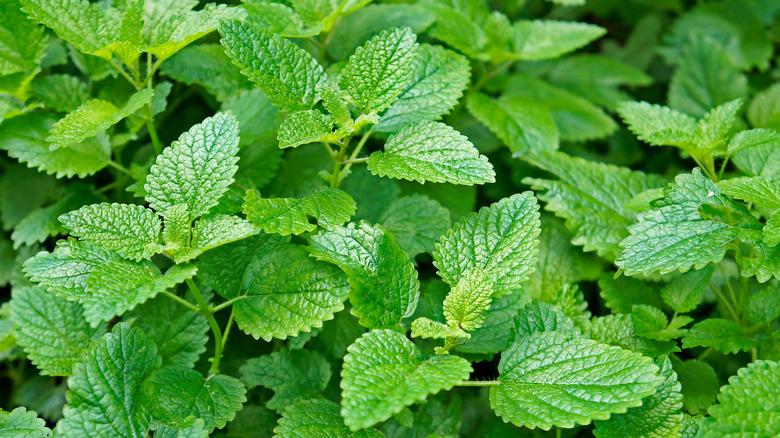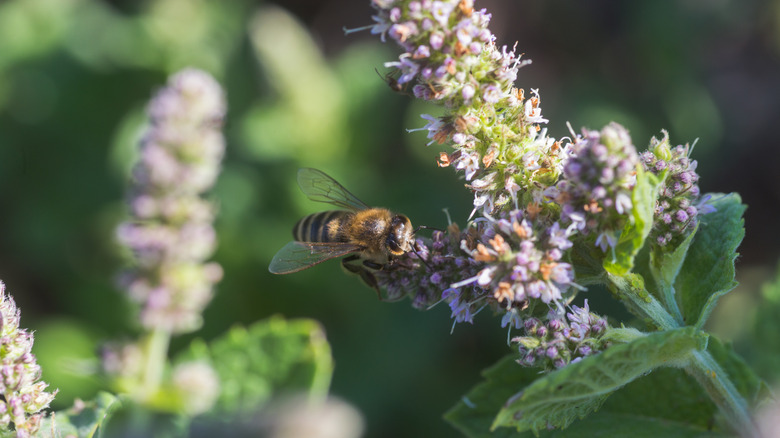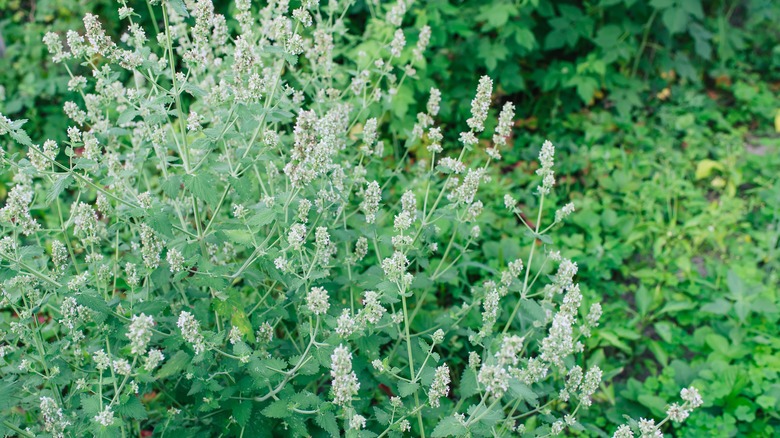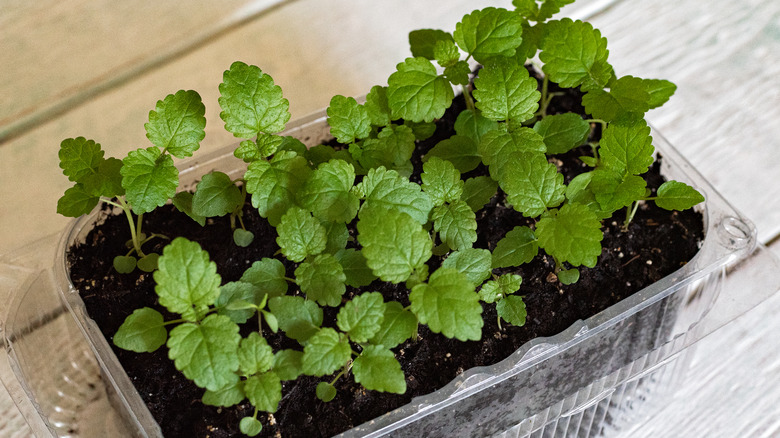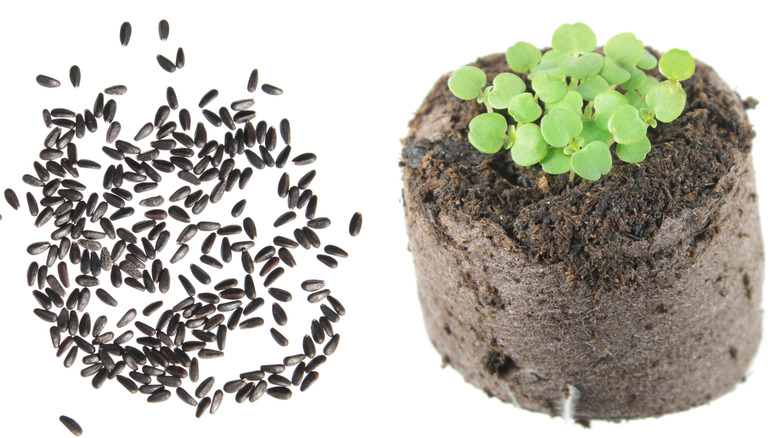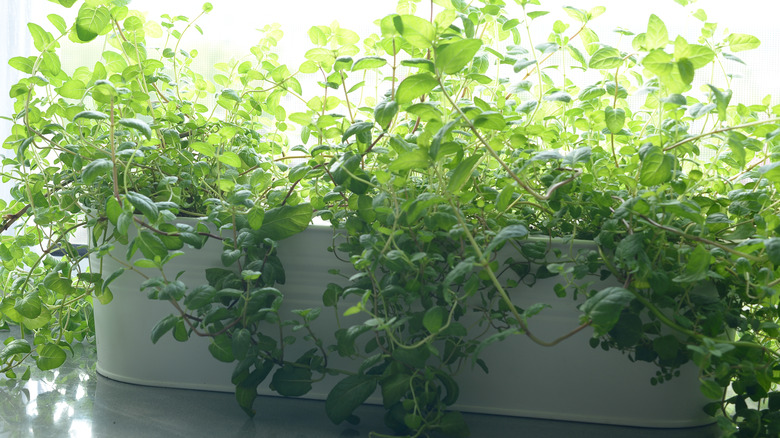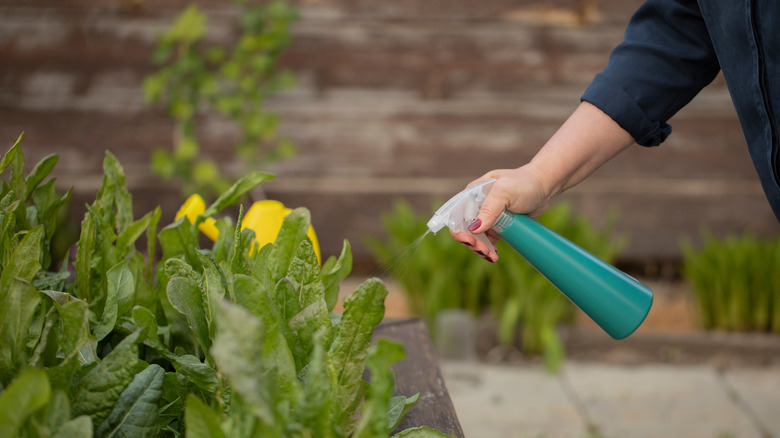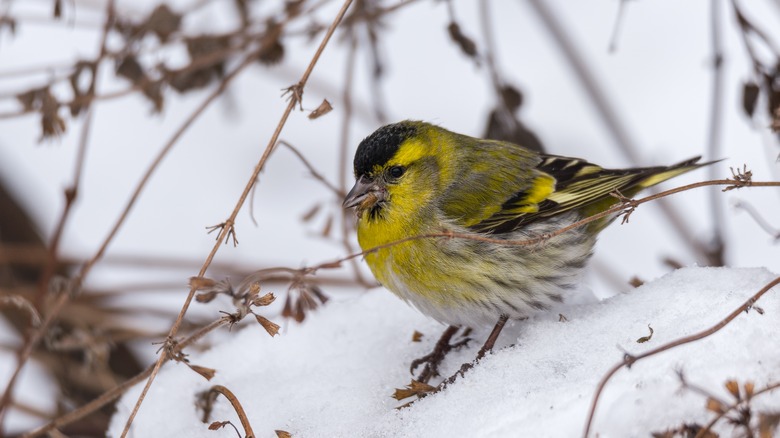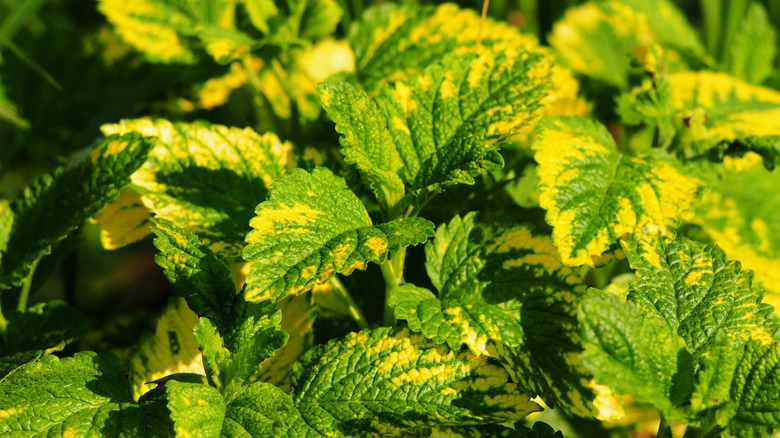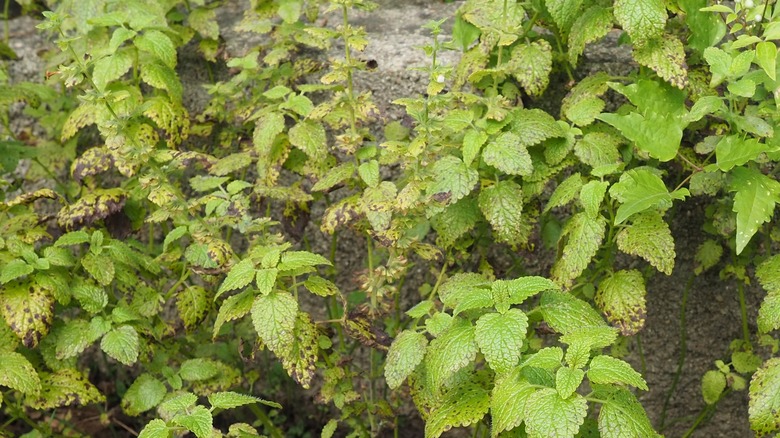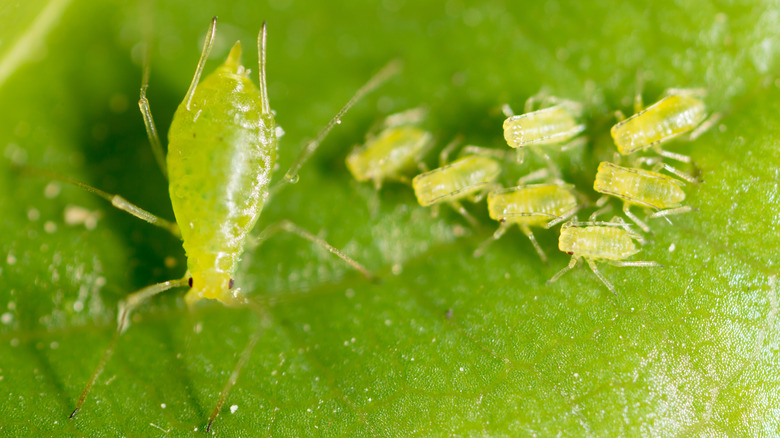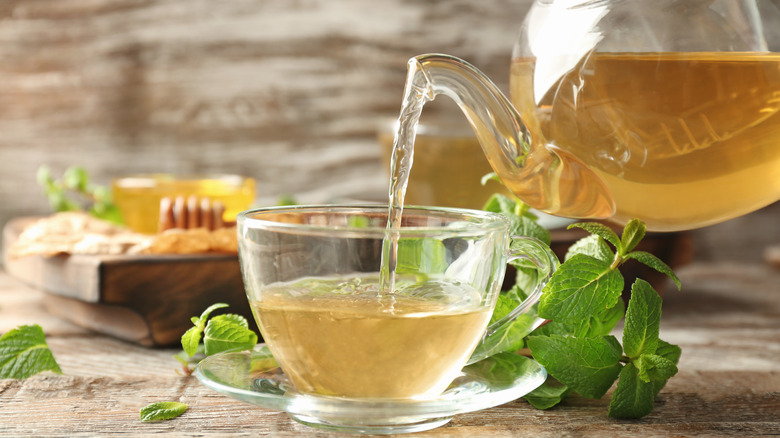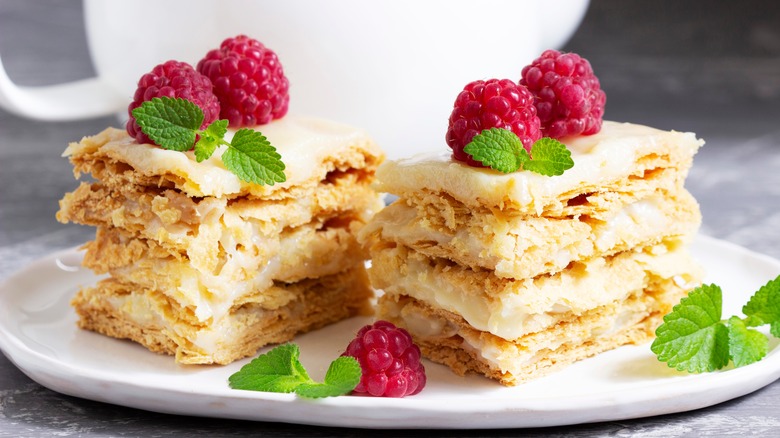How To Grow And Care For Lemon Balm
Lemon balm (Melissa officinalis) is a cold-hardy perennial herb that grows in bush form, 2 to 3 feet tall and up to 3 feet wide, according to North Carolina State Extension Gardener. It has an expansive growth rate and has naturalized itself across the U.S. Loved for its citrus-scented leaves, lemon balm is a top contender for best plants to grow in USDA zone four; however, it will do just fine in any zone from three to seven. In the garden, lemon balm offers small white and purple flowers that will attract pollinating bees. Just be careful to keep it in check because this self-seeder spreads rapidly to the point of becoming invasive.
When kept as a houseplant, it will undoubtedly make your home smell amazing. Lemon balm is also quite adept as a mosquito repellent because it contains high levels of citronellal, which is similar to citronella (via Mother Earth News). All you need to do to experience its repellent effects is crush some leaves in your hand and rub the oil into your skin. Here is how to grow this handy plant in your own garden.
How to use lemon balm in a garden
If you're shopping for herbs to add to your garden, you might see lemon balm labeled with other common names such as heart's delight, balm mint, or blue, garden, or sweet balm, explains Utah State University Horticulture Extension.
Per Plants For a Future, this herb is not very particular when it comes to required growing conditions. It can handle some shade or no shade at all, it's tolerant of different soil qualities so long as excess water drains properly, and it's relatively drought-tolerant. Therefore, it should be easy to find it a suitable home in your garden.
Plus, it is a hermaphroditic plant. Within the jargon of horticulturists, the term hermaphrodite is reserved for plants with flowers that contain both pistils, the female sex organs, and stamen, the male sex organs (via Plantura Magazin). That doesn't necessarily mean the flowers fertilize themselves; bees will still need to be on hand to get the job done for your lemon balm. Interestingly, the first part of the plant's botanical name, Melissa, refers to the Greek goddess who knew how to use honey, the nectar of the gods (via Bee Culture). Perhaps this is a plant to consider if you're designing a pollinator garden.
How to care for and harvest lemon balm
Melissa officinalis is widely considered a low-maintenance, easy-care kind of plant. Once you have it situated in your garden, it should need little more than what nature can provide. Per Plantura Magazine, the arid Mediterranean origins of lemon balm are what set it up for success through periods of mild drought. It will actually fare better overall if exposed to less watering than it will if it gets overwatered.
When you're ready to harvest leaves from a flourishing bush, find the stems that have grown the biggest and flushed out the most. Pick a spot along the stem that is right above a growth point and use sharp scissors to make a clean cut, advises Seedsheet. After harvesting, the plant will send its energy to the growth points to produce new leaves. Lemon balm grows quickly and profusely, so don't worry about holding back when it comes to harvesting and pruning.
How to propagate lemon balm
Shopping for seedlings at the nursery tends to be a wonderful way for gardeners to pass the time, but, of course, it can get expensive. If you have a lemon balm plant from the previous year going strong and you'd like to have more in your garden, perhaps this is the year you try your hand at propagation instead of making a purchase.
According to the Utah State University Horticulture Extension, lemon balm can be started by seed or propagated through cuttings, however, layering is considered a more reliable way. To get started with layering, look along the bottom of your plant for a 6 to 12-inch long healthy and flexible stem. You're going to use a clean, sharp knife to slice a cut into the underside of the stem before burying it a few inches under the soil. Provided light and watering conditions are sufficiently met, within a month or two the stem will grow roots around the point of the cut.
Root division is another option, and an easy one at that. It should be done at the end of the growing season yet before the first frost. Simply dig up your plant and gently break off some of the roots. These can be moved to a new location, planted in a container, or simply set to grow next to the original plant. Before winter sets in, apply mulch around any new growth to protect it. See the section on winterizing below for more informaiton.
How to save lemon balm seeds
Lemon balm seeds are so small that it takes 2,000 of them to reach the weight of a single gram. That's a tiny seed! If you're interested in collecting them from your mature plants so you can try your hand at sowing them the following spring, Sow True Seeds says you'll know they're ready to harvest once the flowers on the plant have dried and become brown, and the seeds themselves have turned to black. This will happen at the tail end of summer or the beginning of fall.
HerbaZest advises a delicate touch for the task, noting that you'll first need to pull the dry flowers away from the stems. These can be rolled around in your hand to loosen the seeds or placed gently into a paper bag and left upside down until the seeds loosen and fall. Store them somewhere dry, dark, and cool for the winter months, and keep in mind that organic seeds will only keep for one year. Because lemon balm has the potential to become invasive, HerbaZest suggests cutting back flowers as they die and only leaving the few from which you intend to collect seeds.
Growing lemon balm in containers
There is absolutely no doubt your lemon balm will be a happy camper in a single pot on its own or as part of a larger container-grown herb garden. In fact, you might be an even happier camper than the herb. Some see lemon balm as an incredibly invasive plant because it can spread to the point of almost taking over a garden. Therefore, growing lemon balm in a contained way may be best for everyone involved.
Patio of Pots notes that you should even choose a relatively small container to keep the plant to a manageable size. The three steps to growing lemon balm are plant, water, and watch. Does it get any easier than that? Even those convinced their thumbs are black will likely have a thriving lemony-scented herb plant with the tiniest bit of effort.
If your container plants are indoors, set them up close to a natural light source. Windowsills, in particular, make for a robust and thriving plant due to the abundant sunlight that streams through, along with protection from the harsher weather elements from the glass pane. It should be a simple path to perennial bliss for your potted lemon balm!
Best fertilizer practices for lemon balm
The task of fertilizing your lemon balm falls right in line with the rest of this plant's relatively carefree routines. Utah State University Horticulture Extension confirms this, saying a twice-yearly application of an all-purpose formula will cover all your bases. Make your first application early in the spring to wake up an overwintered plant and promote new growth. Then wait until after you harvest the plant to use its leaves before fertilizing again.
Planet Natural notes that indoor potted herbs will appreciate a little more attention due to the constraints of the soil in the pot. They suggest starting with an organic fertilizer mixed into the soil at the time of potting. After that, spritz a foliar formulation at half strength directly onto the leaves whenever your herbs look like they're fading.
In both cases, outdoor gardens and indoor pots, be very aware of the potential damage of over-fertilization. Herbs generally do not require high doses, and doing so will negatively impact the strength of their oils, leading to a bland taste and not much fragrance.
How to winterize lemon balm
Lemon balm may look delicate, but it is one of those little-plants-that-could. As mentioned above, it's a cold-hardy perennial. That means it can make it through a winter with temperatures as low as -20 degrees Fahrenheit and be ready to get back to producing herbs and flowers the following year, per Grow Veg.
Even with a cold-hardy plant, you can take some beneficial steps to winterize an outdoor herb garden, explains North Carolina State Extension Gardener. A 2-inch layer of gardening mulch to insulate the soil and protect the roots is a must, and it may be all you need for any herbs from the mint family.
As with all plants, refrain from extensive pruning and fertilizer application by the end of summer. Both of these actions encourage plants to send energy to leaf and flower production, but the new growth won't have time to mature enough to handle frost and freezing temperatures. Furthermore, anytime you prune a plant, it needs time to heal itself at the cut points. Plants that have been freshly cut back too close to a severe drop in seasonal temperatures will not be as hardy as they would be otherwise.
Lemon balm varieties
Of course, you won't go wrong relying on the original Melissa officinalis, which you might also find botanically labeled as lemon balm 'Citronella' or, simply, citronella lemon balm. But for those looking for something a little different, there are a few other varieties to consider growing.
- Melissa officinalis 'Limoncello' should be saved for the truly lemon-crazed among us. It has the strongest fragrance of any lemon balm varieties, so it will really scent up your garden and make for a strong tea. Anyone into aromatherapy might plant this variety simply so they can rub a leaf between their fingers and inhale the calming scent anytime they're in the mood.
- Melissa officinalis 'Lime' is your go-to herb if you prefer the fragrance and flavor of lime over lemon. You could also grow both options in your garden; a combination of the two will make a truly refreshing herbal beverage.
-
Melissa officinalis 'Aurea' is a delightfully variegated variety, meaning its leaves display contrasting colors in splotches or stripes. Shown above, in the example of lemon balm the variegations are bright yellow against the standard Kelly green of the original species.
- Melissa officinalis 'Quedlinburger Niederliegende' is a heck of a mouthful and a lovely variety of lemon balm that is quite similar to the original except that it produces a higher quantity of essential oil. The Quedlinburger part of its unusual name refers to the German town from which it comes. Niederliegende translates to procumbent, a botany-specific word meaning "being or having stems that trail along the ground without rooting" (via Merriam-Webster).
Is lemon balm toxic?
We love good news when it comes to the safety of plants, and there's great news here. As confirmed by the official list of toxic and non-toxic plants kept by the American Society for the Prevention of Cruelty to Animals, lemon balm is absolutely safe. You could even feel comfortable keeping it in your child's bedroom. The plant is not poisonous to cats, dogs, or horses, and it's certainly fine for human consumption given the long list of medicinal uses, which we'll get to in a bit.
Toxicity (or lack thereof) aside, any plant consumed in large quantities by curious pets has the potential to make them sick. Often, pet owners think that their pets, especially dogs, eat plants and grass because their stomachs are bothering them and they're trying to induce themselves to vomit. However, a study published in Applied Behavior Animal Science concluded that's not actually the case. According to the study, the jury is still out on why so many dogs eat plants, but most of this consumption is considered normal behavior, having nothing to do with illness or vomiting.
Common diseases of lemon balm
Powdery mildew and septoria leaf spot are the most common fungal diseases to be aware of with lemon balm. The Herb Society of America explains that hot days with high humidity followed by cool nights lead to powdery mildew. You'll recognize it by the white powder substance coating the leaves. Among the available varieties, Melissa officinalis 'Citronella' will be best for you if you live in a climate that regularly leads to these conditions because it is mildew-resistant. Also, focus on pruning plants back, harvesting leaves regularly, and providing sufficient airflow.
Septoria leaf spot happens when the temperatures and humidity are high, and the leaves stay damp. In accordance with its name, you'll know leaf spot when you see dark brown, sometimes black, splotches on the leaves. Combatting the issue may be as easy as disinfecting your pots, provided you've kept your plants in containers. Otherwise, you might need to dig up and space out your plants.
Another tip is to switch up your watering routine, so the leaves have a chance to dry out throughout the day. Simply shifting to an earlier schedule may help. For more drastic cases, consider installing a drip irrigation system that will water the plants at the soil level rather than spraying them over the top with a garden hose. This is one of the best ways to ensure the leaves stay dry.
Managing aphids on lemon balm
Certainly, the peskiest part of maintaining lemon balm is dealing with the inevitable aphids. These tiny bugs seem to arrive in hoards and can manage quite a bit of damage in a short time if left alone. The Gardening Dad says your course of action against aphids will depend on how many you see. For a small amount, you can remove them by hand; be sure to crush them and throw them away to ensure they are dead and unable to re-infest your plants. After removal, go back to your plant with a wet paper towel and gently wipe away any residual stickiness.
If there's more than you can handle by hand, grab the hose and give your plants a powerful flush to knock the bugs from the leaves. After that, it could be time to move on to insecticidal soap or commercial pesticides.
For those wanting to skip the chemicals altogether, you can try introducing your plants to beneficial insects and hungry birds. Neither will be particularly interested in gnawing on the leaves as the aphids do. Ladybugs and lacewings are quite adept at taking care of an aphid problem at the level of egg and larvae destruction; chickadees and other birds will consume a fair share of the adults. For an added boost of all-natural defense, try essential oils of peppermint, rosemary, thyme, and clove mixed into a tincture and sprayed on bug-infested leaves in the morning.
How to use lemon balm medicinally
If you've got lemon balm growing in your herb garden, Mount Sinai says you have a calming herb on your hands that has long been used to relieve anxiety and encourage quality sleep. Since the Middle Ages, humans have also used the Melissa officinalis plant to reduce gastrointestinal upset and to fight against herpes infection. The herb can be taken internally by extract, mixed into an ointment for direct topical use, or steeped into a tea. Valerian and chamomile are two other great plants to grow for homemade herbal tea. Provided you have the space, we suggest growing all three so you can use them to create the ultimate calming blend, which nutritionists would recommend drinking right before bed.
There are even a few studies that have shown evidence of lemon balm improving cognitive function in those who suffer from Alzheimer's disease. Of course, side effects and contraindications are always a possibility. Consulting with your doctor is advised before diving too deep into medicinal applications.
How to use lemon balm as a cooking herb
The bright, invigorating scent of lemon balm can do more than perk up your mood. How about trying it out in the kitchen as well? The RbPlant Consortium notes that the leaves and flowers can be consumed and suggests both as zesty additions to soups and salads. Food52 takes the culinary prowess of the herb quite a bit further, claiming lemon balm rightly belongs in everything from a couscous dish to cannellini bean croquettes. Pair it with dill, basil, and mint — three more excellent additions to your herb garden.
If you prefer to drink your lemon-flavored kick, it'll taste great mixed into an iced tea. And that doesn't even get us started on the desserts. Per Yummly, the zesty herb can be worked into sorbets, popsicles, cakes, and cookies too. Considering it will be harder to find on grocery shelves than other standard herbs, you might want to pick up a plant the next time you're at a garden center or farmer's market.
